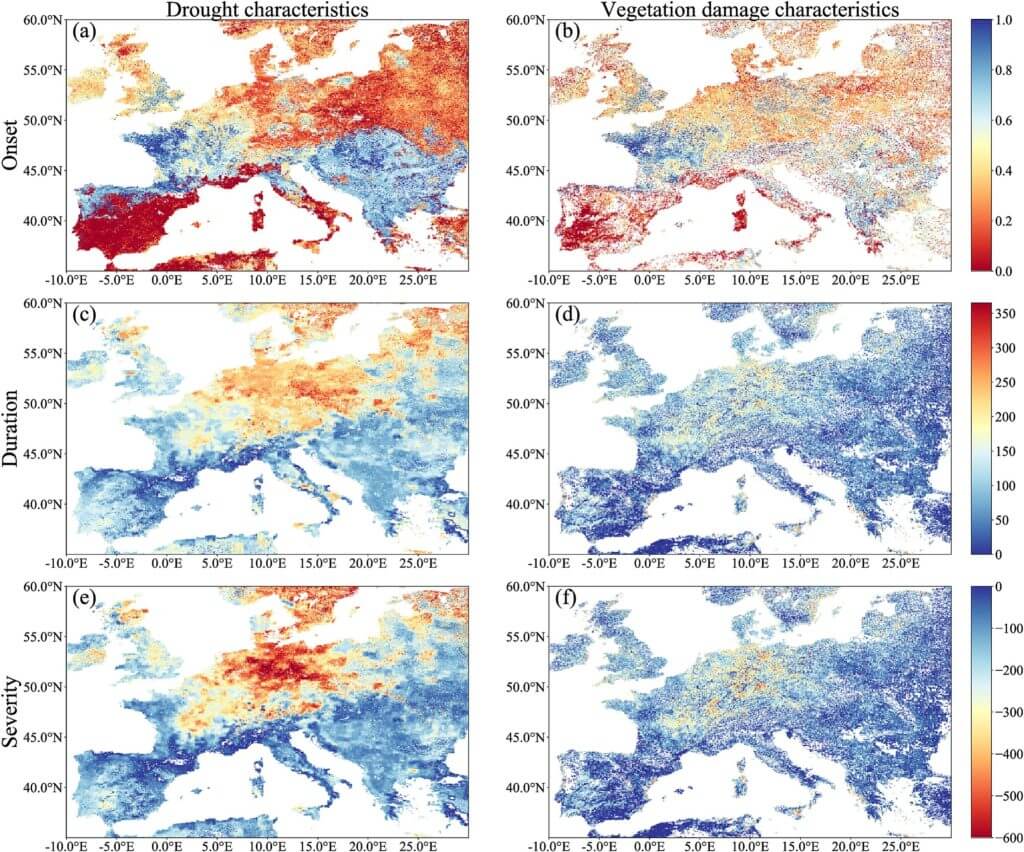
Satellites reveal ecosystems most vulnerable to drought (Image Credit: Phys.org)

More severe droughts that will also last longer: this will primarily be a problem for irrigated croplands, as discovered by environmental scientist Qi Chen. Mixed forests with a variety of plant species will be the least vulnerable. Chen compared the effects of drought on different ecosystems across Europe. She made use of a special tool to do so.
“Plants can’t say, ‘Help! I need some water,'” Qi Chen says jokingly, “but they do tell us things by their physical responses. Changes in, for example, their leaf area, can tell us a lot. Think of the plants in your own garden: if you don’t water them, the leaves will curl or even fall off. Satellites allow us to measure these responses on a large scale.”
Measuring the amount of leaves using satellites
Chen looked at the response of different European ecosystems to the severe drought in 2018. “I distinguished 21 different types of ecosystems and aimed to understand which ones are likely to be the most vulnerable as droughts increase,” she explains. To do so, Chen monitored changes in the leaf area of all ecosystems using satellite images.
“From the air, the satellites capture images of the land surface below. Each pixel in the image covers an area of 1,000 by 1,000 meters. Using the ratio between the leaf area and ground area on each grid, we calculated the so-called Leaf Area Index, an indicator for the real amount of leaf area for each ecosystem.”
To determine the effect of the 2018 drought, Chen compared the leaf area in 2018 across all locations with data from previous years, spanning from 2004 until 2017. This approach allowed her to detect anomalies and determine the extent of drought damage for each type of ecosystem.
Chen’s research revealed that mixed forests, with their diverse plant species and deep-root systems, are the most resilient to drought conditions. “They can draw water from deeper soil layers and employ various survival strategies,” she explains. In contrast, irrigated croplands are highly vulnerable due to their dependency on large amounts of water and a lack of natural drought coping mechanisms.
Damage will increase disproportionately
Chen’s research furthermore reveals a troubling trend: as droughts intensify because of climate change, vegetation damage to most ecosystems will increase disproportionately.
“With rising temperatures and more frequent droughts, the damage will increase at an accelerating rate,” she explains. This disproportional response suggests that even drought-tolerant ecosystems will face severe impairments as drought conditions worsen. Chen said, “In this context, a wide range of ecosystems is more likely to become highly vulnerable and some may even collapse in the coming decades.”
Knowledge like this helps us find the best ways to manage drought and protect vulnerable nature. Chen says, “It’s crucial to know which ecosystems are the most vulnerable and how quickly they may collapse. Do we need to act now? Or does the vegetation in the area have a certain buffer capacity? We could allocate water to the more vulnerable ecosystems and learn from the more resilient ones: what makes them resilient, and can we somehow incorporate that into our management?”
Drones to locate withered trees
Chen envisions a future where we can monitor drought almost in real time. “Satellites with coarse resolution, such as 1 km2 , pass by a specific location every one to two days,” she explains.
During droughts, we could use these satellites to quickly locate areas with signs of drought damage. Forest managers could then send drones to efficiently pinpoint the precise location, or even identify individual plants or trees affected.
Chen adds, “Such targeted, real-time management strategies could revolutionize how we respond to and mitigate the effects of climate change on our natural environments.”
Journal information:
Science of the Total Environment
Provided by
Leiden University
Satellites reveal ecosystems most vulnerable to drought (2024, August 26)
retrieved 27 August 2024
from https://phys.org/news/2024-08-satellites-reveal-ecosystems-vulnerable-drought.html
part may be reproduced without the written permission. The content is provided for information purposes only.





